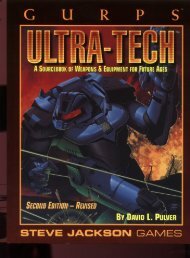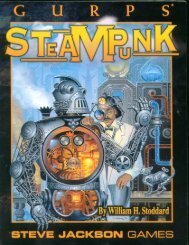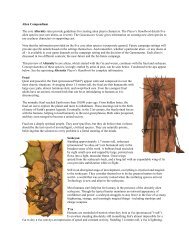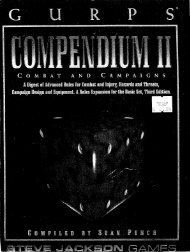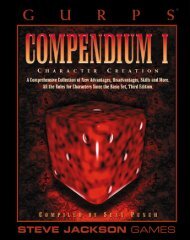their motives? In short, what is happening behind the scenes, and what is the "big pic -ture?" If this adventure is part of a campaign, a lot of the background is set. If it is a"one-shot," the background can be sketchy. But if you're starting a campaign, give thebackground a lot of thought.PlotThe "plot" is your plan for the things that are supposed to happen during the adventure.In a simple adventure, the GM guides the characters from one "encounter," or scene,to the next. Each encounter starts when the characters arrive; then it is played out, andthe next one can begin.In a more sophisticated adventure, the GM will have planned for certain things tohappen at certain times, regardless of the PCs' actions. If there is a murder to be solved, forinstance, some clues may vanish if they are not found in time - and others may not existyet if the characters come on the scene "too soon." The murders may even continue as theplayers investigate (that's one sure way to eliminate a suspect). Likewise, importantNPCs may come and go with little regard for the players' wishes. There is no limit to whatcan happen "offstage" - war can be declared, gold can be discovered in Alaska,Martians can land in England. All these things will present new challenges ...This sort of plot is harder to write, and more demanding for the GM during play.But it will give the players a sense of urgency that is lacking in a plain straight-lineadventure.IntroductionThe purpose of the introduction is to get the players' characters into your plot sothat the game can begin. If the players are not familiar with your game world, youshould tell them a little bit about it. If they know the game world (or are part of a continuingcampaign), you can just set the scene with a few words and start the action. Youshould not give them the whole background. In a well-designed adventure, one of theplayers' objectives will be to find out "what is really going on." Don't give away allyour secrets right at the beginning!The most hackneyed introduction of all (but still one of the best) is the Old Man in theTavern: "You are all strangers in town, looking for adventure. You are sitting in the localtavern when an old man comes up to you . . ." The old man can ask for help, order the PCsout of town, sell them a map, offer to guide them to fame and fortune ... it doesn'tmatter. Whatever he does, he will provide a mouthpiece through which the GM can givethe players a little background and start them off in the right direction. Some other good"mouthpiece" characters for an introductory encounter:An officer briefing a group of military men. supers, troubleshooters or espionageagents to (perform a mission/deliver a message/steal a secret).An injured stranger who staggers up and gasps a few cryptic last words.A strange story in the news (the "mouthpiece" in this case is the person the PCscontact to ask about it - a reporter, a scientist, etc.). Or the GM could let the party witnessthe mysterious event themselves . ..A storyteller, herald or town drunk, passing on an interesting rumor.A wealthy person who offers to hire the party for a dangerous mission.A retired adventurer telling about the treasure he couldn't quite get.An angel or deity visiting the faithful (or fairly faithful) with commands - perhaps ina dream.A villain's henchman, delivering a threat, ransom demand or boast.A friend of one of the characters - or. for that matter, a total stranger rescued fromimmediate danger - who needs help.A lawyer reading a will, which sends the party on a quest for an inheritance.The "mouthpiece" NPC can end the introductory encounter by providing the maps,passwords or whatever the party needs to start the adventure.TrapsFantasy adventures traditionally feature avariety of traps. The novice designer canoverdo this, with a crossbow behind everydoor and a pit in every corridor. If thisdoesn't kill the whole party, it will slowthe game to a crawl as they check everythingin sight for traps - and then checkagain, to make sure. But a few strategically-locatedtraps can make an adventuremore interesting.This is true for adventures in non-fantasygenres as well! A criminal stronghold ormillionaire's mansion may have unpleasantsurprises for the intruder.Primitive natives encountered by explorers,whether in Africa, South America orPlanet Zogbaum, may likewise have someupsettingly sophisticated defenses.Some common types of traps includepoison needles, hidden crossbows or otherranged weapons, hidden giant crossbows(or cannon, or antiaircraft missiles), pits(with spikes, snakes, or both), fallingweights, rolling boulders, sliding walls (ordescending roofs), explosives, chainedbeasts, slippery slides, poison gas, acidsprays and many more. Think of the lasthundred adventure stories you read!Not all traps are deadly. They can bedesigned to cripple, capture, annoy,embarass, or just frighten their victims. Aburglar alarm is nothing more than a trapthat produces only sound!Traps, like rooms, should be shown onthe map key - or a trap in a room can bepart of the room's description. For eachtrap, the key should show:(a) how hard the trap is to notice, andwhat skills can detect it(b) how hard the trap is to disable(and/or set off harmlessly)(c) what will set off the trap(d) what happens if t he trap is set off!Some GMs delight in the invention offiendish traps to test their players' wits.Such a "puzzle trap" cannot be disabled by asimple Traps skill roll, or escaped by anysimple skill roll. The players will have tothink their way out! A very simple examplemight be a sliding-wall trap that will crushthe strongest character to death . . . unlesshe opens the manhole in the floor. It's toosmall for him to fit into - but the lid is ofsuch solid metal that, if held in place, it willblock the closing walls!Much more complex traps are possible.Have fun. "Puzzle" traps can add flavor toan adventure when simple deathtrapsbecome boring.
Features of a GoodAdventureA good adventure (by the standards weuse for our own publications) will include:Lots of opportunities for the PCs to usetheir non-combat skills - including somedifficult rolls, and some involving unusualskills (forcing the PCs to roll againstdefaults).Contests of skill between PCs andNPCs, and possibly between PCs as well.Situations where the players will haveto think about the right thing to do ... puzzles,moral choices, or both.Situations where proper use of socialskills, like Fast-Talk or Diplomacy, willavoid combat.Situations where no possible use ofsocial skills will avoid combat!Interesting descriptions of people,places and things," to give the players thefeeling that they are really there with theircharacters.A clear introduction; a plotline whichbuilds tension or mystery; and a clearconclusion.Opportunity for roleplaying and characterdevelopment. This should be presenteven if the adventure is the most lightheartedhack'n'slash imaginable! Fightersare interesting people, too - or theyshould be.A reward for characters who completethe adventure successfully, and a consequencefor characters who fail!Sample Encounter tableAn encounter table can be used to provideextra interest in an adventure. Part ofits value is that even the GM doesn't knowwhat he's going to roll. An example:Trivial Low-Tech RoadEncounters: roll one die1: A group of farmers (roll 2 dice fornumber)2: One holy hermit3: One not-so-holy beggar4: One merchant with horse, wagon,and 1 to 3 guards5: A single horseman6: NothingMapsAs described under Game Mastering, p. 177, you will need a number of maps - one forevery area you consider "important" to the adventure. Combat maps should be prepared inadvance for any location where a fight is likely.The experienced GM can save a lot of time by "recycling" maps. One house is a lotlike another. One tavern is a lot like another. And so on. Of course, if you always use thesame one, your players will kid you about it... "Aha, here we are, back in the GenericTavern!"Commercially-produced combat maps (from SJ Games, or any number of othercompanies) can also save time. And often an interesting map will suggest an appropriateencounter, helping you to design your adventure!Characters (NPCs and Adversaries)The non-player characters - the characters played by the GM and the Adversary -arevital to an adventure. Often, the whole adventure will be planned around two or threeinteresting NPCs, and what happens when the characters become involved with them.The most important NPCs should be designed first, before you work out theencounters and the other details of the adventure. Their abilities, personalities, motivationand background will set the tone for the whole adventure, and give you ideas forencounters and lesser NPCs. These important NPCs should be worked out according tothe Character Creation rules. You can start them off with 100 points, or even more.Make up a full-scale Character Sheet for each important NPC, and a brief characterstory - so you can roleplay him well.Less important NPCs - spear-carriers, cannon fodder, minor encounters and the like -can be made up after the encounters are planned. You do not need complete stats orCharacter Sheets for these characters - just notes on their important stats. Some trivialcharacters will require no pre-planning at all - if you suddenly need to know (forinstance) a Skill for one of them, you can just roll three dice and use the result.You will also want to work out a few "generic" characters to use, as needed, inimprovised or random encounters. For instance, in an adventure set in a fantasy city, youcould prepare a few city guards, a couple of storekeepers, a couple of thieves, andmaybe a strolling minstrel or wandering drunk. Then, if you need them, you have them. Ifyou don't need them, you have them for next time. (And guards, like taverns, can berecycled over and over again). The pre-generated characters in this and other <strong>GURPS</strong> setsshould be saved; they will come in very handy as instant NPCs.EncountersAn "encounter" is a meeting with NPCs, animals, a trap or anything else the GMwrites into his adventure. Encounters are of three kinds: planned, improvised and random.Ideally, as you run the game, your players should never know which kind is which!Planned encounters are worked out in advance by the GM. He has already decidedthat when the characters come to this place, they will meet these people (or animals, orwhatever). All the important encounters in your adventure should be planned.Of course, few encounters will go exactly as planned. The GM should always beready to adapt to the characters' actions. Suppose a planned encounter involves thebouncer at the "Blue Boar" - but the PCs don't go near there. You can drop a hint tosend them there, of course - but it might be easier to change things a bit. and let theinnkeeper at their rooming-house serve the same purpose. The more flexible you are. themore you can avoid the appearance of manipulating the players. And appearance ismore important than reality!Improvised encounters are "made up" by the GM in order to keep the adventuremoving along planned lines. The simplest "improvised encounter" is the little old man
- Page 3 and 4:
17. FLIGHT.........................
- Page 5 and 6:
Materials Needed for PlayThe GURPS
- Page 7 and 8:
WHAT IS ROLEPLAYING?A roleplaying g
- Page 9 and 10:
Character TypesThere are no "charac
- Page 12 and 13:
Four numbers called "attributes" ar
- Page 14 and 15:
You are free to set the physical ap
- Page 16 and 17:
REPUTATIONSome characters are so we
- Page 18 and 19:
These are character traits that are
- Page 20 and 21:
Legal Enforcement Powers 5, 10 or 1
- Page 22 and 23:
Rapid Healing5 pointsThis advantage
- Page 24 and 25:
A minor deity as Patron to a travel
- Page 26 and 27:
ReputationVariable (see p. 17)Socia
- Page 28 and 29:
Lame-15,-25, or -35 pointsYou have
- Page 30 and 31:
Bad Temper-10 pointsYou are not in
- Page 32 and 33:
Dyslexia-5 or -15 pointsYou have a
- Page 34 and 35:
Pacifism-15 or -30 pointsYou are op
- Page 36 and 37:
Shyness-5,-10,-15 pointsYou are unc
- Page 38 and 39:
You have a significant responsibili
- Page 40 and 41:
A "quirk" is a minor personality tr
- Page 42 and 43:
SpecializingRequired Specialization
- Page 44 and 45:
MEANING OF SKILL LEVELSSo you have
- Page 46 and 47:
Teamster (Mental/Average)Defaults t
- Page 48 and 49:
Skiing (Physical/Hard)Defaults to D
- Page 50 and 51:
Guns/TL (Physical/Easy)Defaults to
- Page 52 and 53:
Any of these skills can be self-tau
- Page 54 and 55:
Levels of Language SkillThis table
- Page 56 and 57:
Most outdoor skills can be learned
- Page 58 and 59:
PSIONIC SKILLSThese are special men
- Page 60 and 61:
Forensics/TL (Mental/Hard)Defaults
- Page 62 and 63:
Few Hundred Acres: Knowledge of far
- Page 64 and 65:
Many skills in this category are ta
- Page 66 and 67:
Lockpicking/TL (Mental/Average) Def
- Page 68 and 69:
Gunner/TL See Combat Skills, p. 50M
- Page 70 and 71:
Now you need to decide what equipme
- Page 72 and 73:
Each suit of "real" armor includes
- Page 74 and 75:
Listing Weapons On Your Character S
- Page 76 and 77:
Recording Encumbrance on YourCharac
- Page 78 and 79:
Passive Defense. The first blank is
- Page 80 and 81:
The longer (and the more skillfully
- Page 82 and 83:
When you improve a skill, the cost
- Page 84 and 85:
Not all the advantages and disadvan
- Page 86 and 87:
But remember . . . some skills have
- Page 88 and 89:
ClimbingTo climb anything more diff
- Page 90 and 91:
SwimmingThe Swimming skill (p. 49)
- Page 92 and 93:
WILL ROLLSWhen a character is faced
- Page 94 and 95:
The GURPS combat system is designed
- Page 96 and 97:
WaitDo nothing unless a foe comes w
- Page 98 and 99:
You may only block one attack per t
- Page 100 and 101:
Missile WeaponsMissile weapons are
- Page 102 and 103:
At the end of your move, if you hav
- Page 104 and 105:
The rules for attacking a foe are e
- Page 106 and 107:
tell you how long it will take. In
- Page 108 and 109:
You may normally parry only one att
- Page 110 and 111:
CLOSE COMBATUsing the Move, Step an
- Page 112 and 113:
(adjusted) ST! Note that a shield h
- Page 114 and 115:
Ranged Weapon StatsFor each ranged
- Page 116 and 117:
second. On the table, this rounds u
- Page 118 and 119:
If you are using the "hit location"
- Page 120 and 121:
Removing or folding the stock of a
- Page 122 and 123:
After the initial "freeze" ends, ea
- Page 124 and 125:
ATTACKING INANIMATE OBJECTSThere ar
- Page 126 and 127:
This subtraction will mostoften aff
- Page 128 and 129:
Psionic healing (p. 175) and magica
- Page 130 and 131:
DrowningSee the rules for Swimming,
- Page 132 and 133:
protects completely. Toughness prot
- Page 134 and 135:
Resolving mounted or vehicular comb
- Page 136 and 137:
Using Ranged Weapons From Horseback
- Page 138 and 139:
This section covers special rules f
- Page 140 and 141:
HT: Health and Hit PointsFor a roug
- Page 142 and 143:
Swarm AttacksA group of small creat
- Page 144 and 145:
Encumbrance and MovementEncumbrance
- Page 146 and 147: A critical miss means the energy co
- Page 148 and 149: oll will not end the spell, but the
- Page 150 and 151: If the subject makes the resistance
- Page 152 and 153: won't work. If anyone but the caste
- Page 154 and 155: ANIMAL SPELLSThese are the spells r
- Page 156 and 157: If the summoning spell is repeated,
- Page 158 and 159: Cost: 1 for an object up to the siz
- Page 160 and 161: Armor EnchantmentsThese spells work
- Page 162 and 163: AuraInformationShows the caster a g
- Page 164 and 165: Psionics, or "psi" abilities, are p
- Page 167 and 168: GlossaryESP - Extra-Sensory Percept
- Page 169 and 170: Psionics and MagicMagic and psionic
- Page 171 and 172: PSYCHOKINESISThis power covers movi
- Page 173 and 174: Pside EffectsPsi skills can have "s
- Page 175 and 176: Limitations(Continued)Fickle: varia
- Page 177 and 178: Player-Made MapsWhenever the player
- Page 179 and 180: Predetermined ReactionsCertain NPCs
- Page 181 and 182: Dealing with the PlayersArgumentsAs
- Page 183 and 184: Time Use SheetsThe Time Use Sheet (
- Page 185 and 186: Weapons and Armor0. Fists and stone
- Page 187 and 188: Weather(Continued)WindWinds from ga
- Page 189 and 190: Gold and SilverA traditional assump
- Page 191 and 192: JobsThe jobs available in each game
- Page 193 and 194: Job (Prerequisites), Monthly Income
- Page 195: Sooner or later, every GM wants to
- Page 199 and 200: World-BuildingA game world is a com
- Page 201 and 202: CRITICAL HIT TABLEAll doublings or
- Page 203 and 204: When the players meet an NPC whose
- Page 205 and 206: Weapons are listed in groups, accor
- Page 207 and 208: MODERN AND ULTRA-TECH WEAPONSWeapon
- Page 209 and 210: ANCIENT/MEDIEVAL ARMORUse this tabl
- Page 211 and 212: FANTASY/MEDIEVAL EQUIPMENTThe follo
- Page 231 and 232: After eight printings of the GURPS
- Page 233 and 234: of Divination should match the "fla
- Page 235 and 236: Minor disadvantage: -5 points. Agai
- Page 237 and 238: Whether through an accident of birt
- Page 239 and 240: Note that this disadvantage is inco
- Page 241 and 242: SKILLSARTISTIC SKILLSVideo Producti
- Page 243 and 244: traders, and chess-like games are c
- Page 245 and 246: If, during an adventure, a philosop
- Page 247 and 248:
VITAL ORGANSThese are optional rule
- Page 256 and 257:
INSTANT CHARACTERSThis quick refere





